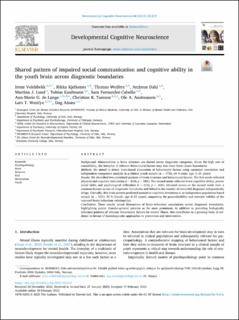| dc.contributor.author | Voldsbekk, Irene | |
| dc.contributor.author | Kjelkenes, Rikka | |
| dc.contributor.author | Wolfers, Thomas | |
| dc.contributor.author | Dahl, Andreas | |
| dc.contributor.author | Lund, Martina Jonette | |
| dc.contributor.author | Kaufmann, Tobias | |
| dc.contributor.author | Fernandez-Cabello, Sara | |
| dc.contributor.author | de Lange, Ann-Marie Glasø | |
| dc.contributor.author | Tamnes, Christian Krog | |
| dc.contributor.author | Andreassen, Ole | |
| dc.contributor.author | Westlye, Lars Tjelta | |
| dc.contributor.author | Alnæs, Dag | |
| dc.date.accessioned | 2023-09-18T13:45:31Z | |
| dc.date.available | 2023-09-18T13:45:31Z | |
| dc.date.created | 2023-02-21T17:06:17Z | |
| dc.date.issued | 2023 | |
| dc.identifier.citation | Developmental Cognitive Neuroscience, 2023. 60. | en_US |
| dc.identifier.issn | 1878-9293 | |
| dc.identifier.uri | https://hdl.handle.net/11250/3090164 | |
| dc.description.abstract | Background
Abnormalities in brain structure are shared across diagnostic categories. Given the high rate of comorbidity, the interplay of relevant behavioural factors may also cross these classic boundaries.
Methods
We aimed to detect brain-based dimensions of behavioural factors using canonical correlation and independent component analysis in a clinical youth sample (n = 1732, 64 % male, age: 5–21 years).
Results
We identified two correlated patterns of brain structure and behavioural factors. The first mode reflected physical and cognitive maturation (r = 0.92, p = .005). The second mode reflected lower cognitive ability, poorer social skills, and psychological difficulties (r = 0.92, p = .006). Elevated scores on the second mode were a common feature across all diagnostic boundaries and linked to the number of comorbid diagnoses independently of age. Critically, this brain pattern predicted normative cognitive deviations in an independent population-based sample (n = 1253, 54 % female, age: 8–21 years), supporting the generalisability and external validity of the reported brain-behaviour relationships.
Conclusions
These results reveal dimensions of brain-behaviour associations across diagnostic boundaries, highlighting potent disorder-general patterns as the most prominent. In addition to providing biologically informed patterns of relevant behavioural factors for mental illness, this contributes to a growing body of evidence in favour of transdiagnostic approaches to prevention and intervention. | en_US |
| dc.language.iso | eng | en_US |
| dc.subject | Psychopathology | en_US |
| dc.subject | Youth | en_US |
| dc.subject | social communication | en_US |
| dc.subject | cognitive ability | en_US |
| dc.subject | brain-behaviour associations | en_US |
| dc.title | Shared pattern of impaired social communication and cognitive ability in the youth brain across diagnostic boundaries | en_US |
| dc.title.alternative | Shared pattern of impaired social communication and cognitive ability in the youth brain across diagnostic boundaries | en_US |
| dc.type | Peer reviewed | en_US |
| dc.type | Journal article | en_US |
| dc.description.version | publishedVersion | en_US |
| dc.source.volume | 60 | en_US |
| dc.source.journal | Developmental Cognitive Neuroscience | en_US |
| dc.identifier.doi | 10.1016/j.dcn.2023.101219 | |
| dc.identifier.cristin | 2127962 | |
| dc.source.articlenumber | 101219 | en_US |
| cristin.ispublished | true | |
| cristin.fulltext | original | |
| cristin.qualitycode | 2 | |
